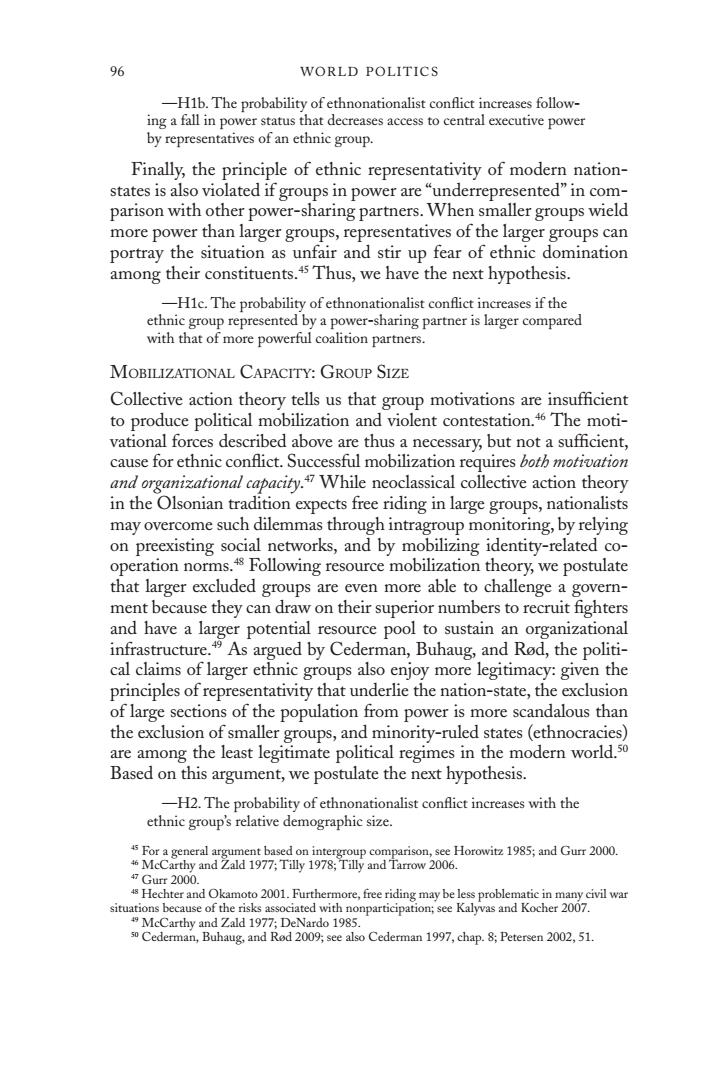正在加载图片...

96 WORLD POLITICS -H1b.The probability of ethnonationalist conflict increases follow- ing a fall in power status that decreases access to central executive power by representatives of an ethnic group. Finally,the principle of ethnic representativity of modern nation- states is also violated if groups in power are"underrepresented"in com- parison with other power-sharing partners.When smaller groups wield more power than larger groups,representatives of the larger groups can portray the situation as unfair and stir up fear of ethnic domination among their constituents.Thus,we have the next hypothesis. -H1c.The probability of ethnonationalist conflict increases if the ethnic group represented by a power-sharing partner is larger compared with that of more powerful coalition partners. MOBILIZATIONAL CAPACITY:GROUP SIZE Collective action theory tells us that group motivations are insufficient to produce political mobilization and violent contestation.The moti- vational forces described above are thus a necessary,but not a sufficient, cause for ethnic conflict.Successful mobilization requires both motivation and organizational capacity.While neoclassical collective action theory in the Olsonian tradition expects free riding in large groups,nationalists may overcome such dilemmas through intragroup monitoring,by relying on preexisting social networks,and by mobilizing identity-related co- operation norms.Following resource mobilization theory,we postulate that larger excluded groups are even more able to challenge a govern- ment because they can draw on their superior numbers to recruit fighters and have a larger potential resource pool to sustain an organizational infrastructure.As argued by Cederman,Buhaug,and Rod,the politi- cal claims of larger ethnic groups also enjoy more legitimacy:given the principles of representativity that underlie the nation-state,the exclusion of large sections of the population from power is more scandalous than the exclusion of smaller groups,and minority-ruled states(ethnocracies) are among the least legitimate political regimes in the modern world.so Based on this argument,we postulate the next hypothesis. -H2.The probability of ethnonationalist conflict increases with the ethnic group's relative demographic size. For a general argument based on intergroup comparison,see Horowitz 1985;and Gurr 2000 46 McCarthy and Zald 1977;Tilly 1978;Tilly and Tarrow 2006 47Gur2000. 4 Hechter and Okamoto 2001.Furthermore,free riding may be less problematic in many civil war situations because of the risks associated with nonparticipation;see Kalyvas and Kocher 2007. McCarthy and Zald 1977;DeNardo 1985. 50 Cederman,Buhaug,and Rod 2009;see also Cederman 1997,chap.8;Petersen 2002,51.96 world politics —H1b. The probability of ethnonationalist conflict increases following a fall in power status that decreases access to central executive power by representatives of an ethnic group. Finally, the principle of ethnic representativity of modern nationstates is also violated if groups in power are “underrepresented” in comparison with other power-sharing partners. When smaller groups wield more power than larger groups, representatives of the larger groups can portray the situation as unfair and stir up fear of ethnic domination among their constituents.45 Thus, we have the next hypothesis. —H1c. The probability of ethnonationalist conflict increases if the ethnic group represented by a power-sharing partner is larger compared with that of more powerful coalition partners. Mobilizational Capacity: Group Size Collective action theory tells us that group motivations are insufficient to produce political mobilization and violent contestation.46 The motivational forces described above are thus a necessary, but not a sufficient, cause for ethnic conflict. Successful mobilization requires both motivation and organizational capacity. 47 While neoclassical collective action theory in the Olsonian tradition expects free riding in large groups, nationalists may overcome such dilemmas through intragroup monitoring, by relying on preexisting social networks, and by mobilizing identity-related cooperation norms.48 Following resource mobilization theory, we postulate that larger excluded groups are even more able to challenge a government because they can draw on their superior numbers to recruit fighters and have a larger potential resource pool to sustain an organizational infrastructure.49 As argued by Cederman, Buhaug, and Rød, the political claims of larger ethnic groups also enjoy more legitimacy: given the principles of representativity that underlie the nation-state, the exclusion of large sections of the population from power is more scandalous than the exclusion of smaller groups, and minority-ruled states (ethnocracies) are among the least legitimate political regimes in the modern world.50 Based on this argument, we postulate the next hypothesis. —H2. The probability of ethnonationalist conflict increases with the ethnic group’s relative demographic size. 45 For a general argument based on intergroup comparison, see Horowitz 1985; and Gurr 2000. 46 McCarthy and Zald 1977; Tilly 1978; Tilly and Tarrow 2006. 47 Gurr 2000. 48 Hechter and Okamoto 2001. Furthermore, free riding may be less problematic in many civil war situations because of the risks associated with nonparticipation; see Kalyvas and Kocher 2007. 49 McCarthy and Zald 1977; DeNardo 1985. 50 Cederman, Buhaug, and Rød 2009; see also Cederman 1997, chap. 8; Petersen 2002, 51